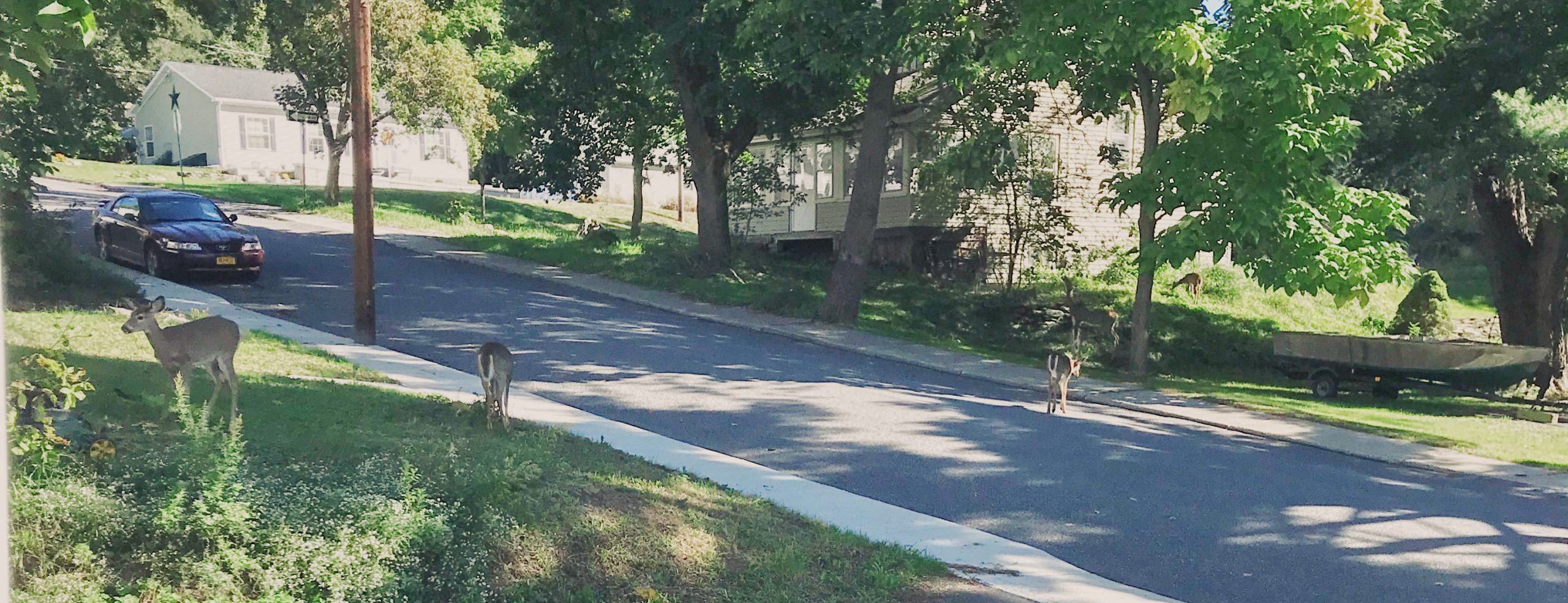FAQs for Participating Towns
Overview
What work will be conducted in my town?
This research project will gather information to better understand deer populations and the factors affecting their presence in the suburbs in Massachusetts and New York. We are interested in the following questions: What is driving deer population changes? And how are communities responding to these changes?
We plan to conduct case studies in 11 towns across MA and NY to understand these questions. Our work will provide information to residents and town officials that can support efforts to assess the presence and impacts of deer and the evaluation of various options for management of white-tailed deer.
Our research will take place over three years and will consist of three main activities in the participating towns:
Deer Population Monitoring: Using wildlife cameras, we will monitor deer populations and other wildlife on a sample of public and private lands in each participating town. The cameras will run over three years and will need maintenance 2-4 times a year.
Vegetation Surveys: To measure forest health and deer impacts to the environment, we will conduct vegetation surveys of the plant life around the sites where the cameras are placed each summer for the duration of the project.
Interviews and Focus Groups with Town Residents and Stakeholders: To understand the diverse perspectives of actors within participating towns, we will be conducting interviews with town officials, residents, large landowners, and other stakeholders on topics of deer and deer management. We will also conduct focus groups with residents tentatively in the Fall of 2021.
We will take the data from these three research activities and create models of different deer population and management scenarios at the local and regional levels to understand how this system works — what are the possible scenarios that arise when municipalities are deciding what to do about deer?
Who is funding this research?
The research is funded by awards from the National Science Foundation (Award #1832191 and Award #1923668)
What municipalities are participating in the project?
In Massachusetts, we are working with Carlisle, Easton, Lincoln, Pepperell, Sharon, and Weston.
In New York, we are still finalizing the list of municipalities. This will be updated as we confirm the participating towns.
Fieldwork
How do wildlife cameras help us understand deer?
Wildlife cameras are activated and take a photo when they detect the movement of a large presence like a deer or other wildlife. Using these cameras will allow us to understand deer presence in different areas of the participating towns as well as other wildlife, and their potential interactions.
Where will the cameras be placed? How were these sites decided?
Prior to camera placement, sample sites were selected within participating towns in order to maximize diversity in forest cover, land use, and wildland-urban interface using principal component analysis (PCA). This site selection process allows us to understand how deer populations and their impacts vary within and between individual towns. We will place cameras in areas that minimize the likelihood of taking pictures of people (pointed away from houses, sidewalks, back yards, etc.). These cameras will be secured to the tree with cable lock (similar to a bike lock) which will cause no damage to the trees.
What is a vegetation survey?
Deer, through their diet and browsing patterns, can impact forest health. Deer consume smaller plants in the forest understory including saplings, shrubs, and wildflowers. To understand how deer are impacting the ecosystem, we will conduct vegetation surveys of the plant life growing in the same sites where the cameras are placed. We will identify and count the number and types of plants found and assess any impacts from deer or other activities. No plants will be cut or collected. We will conduct these surveys in an area of 50×50 ft each summer for the duration of the project.
Who will be interviewed for this project?
We are interested in understanding the diverse perspectives on deer and what to do about them in the participating towns. We will be speaking with current and former town officials, land managers, non-profit organizations, community groups, and residents on these topics. If you live, work, or have an interest in one of the participating towns and would like to talk to us about deer, we’d love to hear from you. Fill out our contact form and we will get in touch.
Where will the interviews take place and how long will they last?
Interviews will be conducted at the convenience of the participant, either via Zoom or in person, and last about 45 minutes to an hour.
Data
Who will have access to the photos from the cameras?
Photos of wildlife will be shared with the landowner or steward by request. Any photos of people will be kept confidential and not shared with anyone.
Who will have access to the vegetation survey data?
We plan to provide annual updates to participating towns via presentations at local government meetings as well as written reports shared with town residents and shared on this site.
Will my name and information be shared if I participate in an interview?
No, we will keep your name and any information that could identify you confidential and not share it with anyone outside the research team.
Who will have access to the findings from this research?
We plan to provide a project summary at the conclusion of our research to the participating towns as well as shared on this site.
Outcomes
Will you tell our town officials what to do about deer?
No. Our research is not designed to predict future deer populations or to propose solutions for any of the focal towns. We want to understand the range of possible outcomes and then provide that information to you to discuss and explore options.
Other questions not addressed here? Send us a message here: Contact Form
